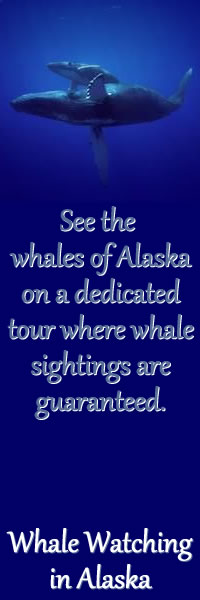 |
Alaska whale watching tours allow the visitors an opportunity to observe and photograph Humpback, Orca, Gray, and Beluga whales, along with many other marine mammals, in their natural environment. |
 |
Captains Choice Whale-Watching-Alaska.com |
 |
Contact Us At: |
 |
|
 |
|
Bottlenose Whales, Baird’s Beaked Whales of Alaska
Baird's Beaked Whale AKA Bottlenose Whales Also known as Baird’s beaked whale, the bottlenose whale is the second largest of the toothed whales. THis species is only found in the Pacific Ocean north of the equator and ranges from Baja California, along the western Canadian coast, past southeastern Alaska, the Aleutian Chain up to the Bering Sea. The bottlenose whales have jaws that form beaks. They have four teeth at the front of the lower jaw. The average male’s body length is 30-39 feet long and females 42 feet long. Their long, cigar shaped bodies are slate-gray in color but can look dark blue in the upper dorsal part of their body. They are usually scarred from encounters with other whales. The older they are the more scales they have. From a distance the bottlenose whale or Baird’s beaked whale, can be confused with other beaked or the minke whale. The bottlenose whale usually inhabits deeper waters than frequented by these other whales. When they surface to breathe they bring their head out of the water at an angle which clearly shows their beak. The beak looks much like that of a bottlenose dolphin. They eat primarily squid but also like rockfish, herring and octopus. Diving to around 3,300 feet, the North Pacific bottlenose whale is a deep diver in dives lasting 20 minutes to an hour. The bottlenose whale’s habitat is steep underwater geologic structures such as submarine canyons, seamounts, and continental slopes. As they spend so much time at such depths researchers believe that the bottlenose whale likely has poor vision, good hearing, and excellent echolocation skills. They can be found in pods from ten to a hundred. The larger pods are lead by an older male. Pods consist of various combinations and might be segregated depending on age, sex, or stage in life. Males are known to be combative, using their large heads to "butt" one another. Not much is known about this whale as they are difficult for whale watchers to approach. Their behavior is skittish and they have a small, inconspicuous blow at the surface of the water. The bottlenose whale may live to 50-70 years. No population estimates exist for the Alaska stock of the Baird’s beaked whale due to unavailable data. It is estimated that there are between 150-250 animals off the U.S. west coast (California/Oregon/Washington stock) and 7,000 in the western Pacific Ocean. The main predator of the bottlenose whale or Baird’s beaked whale, is the killer
whale. Whale Watching Alaska | Whale Watching | Whales in Alaska | Whale Watching Tours | Killer Whales Here on Whale Watching Alaska you will find information on Alaska whale populations, distributions and over all health. Promotes environmentally responsible whale watching trips featuring gray whale, killer whale, humpback whale, beluga and whale pod photo. Experience Juneau, Alaska Whale Watching trips and tours and discover the difference. Personalized whale watching tour. 1 to 6 passengers. This is your Alaska tour, done your way. See a large selection of quality Alaskan whale watching trips in Juneau, a leading one stop tour operator for adventure and exceptional Alaska travel. Numbers obtained from the Alaska Dept. of Fish and Game. Webmasters, Add A Link To Us. HTML Code: <strong><a href="http://www.whale-watching-alaska.com/whale/bairdsbeakedwhalesalaska.html">Baird's Beaked Whale</a></strong>: Explore the watery world of the Whales of Alaska! Information about times and tours as well as the locations of departure from the many ports of call in Alaska. All images on this page are created by Whales of Alaska, the design team editors for this site. Please use images freely without alteration, and check back for updates. If you have any suggestions for us, or if you need an image with different dimensions than those offered here, please contact Bob Jameson or the Whales of Alaska Web Team with details. Contact
|
